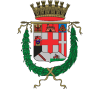Designed in 1496 by Annibale Maggi da Bassano, this elegantly sober building of harmonious proportions is a masterpiece of Renaissance architecture in the city. Construction on it was halted temporarily by the War of the League of Cambrai in 1509, but worked then resumed in 1530 under the Veronese architect Giovanni Maria Falconetto, who would also work on the Clock Tower and redesign the layout of Piazza dei Signori.
A wide flight of steps leads up to a loggia whose facade is a seven-arch arcade, with the arches then continuing along the short sides of the building. The marble ceiling under the arcade is adorned with crests, and to the left is the doorway that leads through to a monumental staircase up to the first-floor hall. That room has a coffered ceiling, and the long walls are decorated with a series of frescoes. Painted in 1667, these depict various legendary episodes such as the mythical foundation of the city by Antenor, the Paduan victory over the fleet of the Spartan king Cleonymus and the suicide of Thrasea Paetus.
Since 1866 the loggia has been owned by the City Council and is used for cultural events. Overlooking one of the most bustling squares in Padua, this symbol of the city’s cultural life is a common meeting-point for residents and tourists alike, as well as being a significant part of the city’s history and architecture.
- DISCOVER
- LIVE
FOCUS
- GET INSPIRED
FOCUS
- INFO
- BOOK NOW












